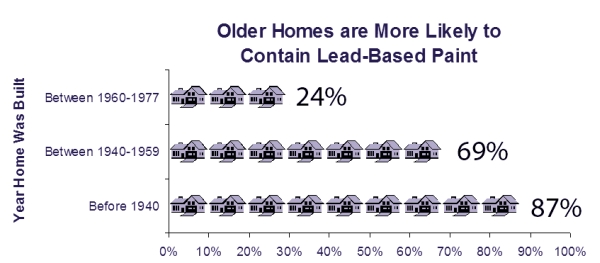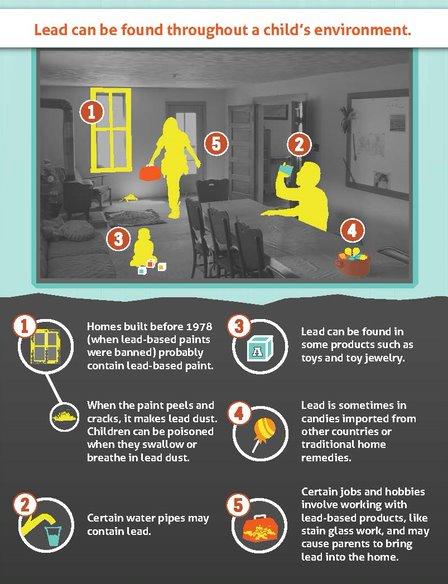Protect Your Family from Sources of Lead
Lead from paint, dust and soil in and around your home can be dangerous if not managed properly.
This page provides information about potential sources of lead in:
- Older homes and buildings
- Soil, yards and playgrounds
- Dust
- Products
- Drinking water
- Jobs and hobbies
- Folk remedies
For more information about protecting your family from exposure to lead:
Older Homes and Buildings
If your home was built before 1978, it is more likely to have lead-based paint. In 1978, the federal government banned consumer uses of lead-based paint, but some states banned it even earlier.

Lead paint is still present in millions of homes, sometimes under layers of newer paint. If the paint is in good shape, the lead paint is usually not a problem. Deteriorating lead-based paint (peeling, chipping, chalking, cracking, damaged, or damp) is a hazard and needs immediate attention.
Lead-based paint may also be a hazard when found on surfaces that children can chew or that get a lot of wear-and-tear, such as:
- Windows and window sills;
- Doors and door frames; and
- Stairs, railings, banisters, and porches.
A few tips to reduce sources of lead exposure in older homes and buildings:
- Inspect and keep all painted surfaces in excellent shape and clean up dust frequently with a wet cloth or paper towel. Read about simple steps to protect your family from lead hazards (PDF).
- Consult a certified lead professional before beginning renovation, repair or painting projects. Renovation, repair or painting activities can create toxic lead dust when painted surfaces are disturbed or demolished. Learn more about hiring lead-safe certified contractors.
- Avoid tracking lead dust into the home by wiping and removing shoes before entering the home and placing dust mats both inside and outside of entryways. Read more about lead dust.
- Learn if you have a lead service line. Contact your water utility or a licensed plumber to determine if the pipe that connects your home to the water main (called a service line) is made from lead. Read more about lead in drinking water.
Soil, Yards and Playgrounds
Soil, yards and playgrounds can become contaminated when exterior lead-based paint from houses or buildings flakes or peels and gets into the soil. Soil may also be contaminated from past use of leaded gasoline in cars, from industrial sources, or even from contaminated sites, including former lead smelters. Lead is also naturally occurring and it can be found in high concentrations in some areas.
Lead in soil can be ingested as a result of hand-to-mouth activity that is common for young children and from eating vegetables that may have taken up lead from soil in the garden. Lead in soil may also be inhaled if resuspended in the air or tracked into your house thereby spreading the contamination.
Older playground equipment can still contain old lead-based paint, and artificial turf and playground surfaces made from shredded rubber can contain lead. Take precautions to ensure young children do not eat shredded rubber or put their hands in their mouth before washing them. Read more on playgrounds and artificial turf fields.
To reduce exposures to lead from soils, yards and playgrounds:
- Check the exterior of your home, including porches and fences, for flaking or deteriorating lead-based paint that may contaminate soil in your yard or be tracked into your house.
- Put doormats outside and inside all entryways and remove your shoes before entering to avoid tracking contaminated soil into your house.
- Wash hands several times a day using soap and water, especially after playing or working outside.
- Plant bushes close to the house to keep children from playing in soil near your home.
Dust
Lead in household dust results from indoor sources such as old lead-based paint on surfaces that are frequently in motion or bump or rub together (such as window frames), deteriorating old lead-based paint on any surface, home repair activities, tracking lead-contaminated soil from the outdoors into the indoor environment, or even from lead dust on clothing worn at a job site.
Even in well-maintained homes, lead dust can form when lead-based paint is scraped, sanded or heated during home repair activities. Lead paint chips and dust can get on surfaces and objects that people touch. Settled lead dust can re-enter the air when the home is vacuumed or swept, or people walk through it.
To reduce exposure to lead dust, it is especially important to:
- Maintain all painted surfaces in good condition.
- Clean frequently using a wet mop, cloth or sponge to reduce the likelihood of chips and dust forming.
- Use a lead-safe certified renovator to perform renovation, repair and painting jobs to reduce the likelihood of contaminating your home with lead dust. Find a lead-safe certified firm near you.
Products
Lead has been used for a long time in a wide variety of products found in and around our homes, including painted toys, furniture and toy jewelry; cosmetics; food or liquid containers; and plumbing materials.
That favorite dump truck or rocking chair handed down in the family, antique doll furniture or toy jewelry could contain lead or lead-based paint. The Consumer Product Safety Commission (CPSC) has a comprehensive program on lead in toys including toy jewelry.Exit Biting or swallowing toys or toy jewelry that contain lead can cause a child to suffer from lead poisoning. To help protect against that risk, CPSC has put protections in place that ban the use of lead in many children’s products. For example:
- In 2004, the threat of lead poisoning from toy jewelry led the CPSC to conduct a voluntary recall of 150 million pieces of metal toy jewelryExitsold widely in vending machines.
- In 2007, CPSC issued a press release announcing the Fisher-Price recall of 967,000 toys due to lead poisoning hazard.Exit
- Toy jewelry containing unsafe levels of lead has continued to be sold even after CPSC issued guidance to prevent the sale of these products. Other products containing lead have also been recalled, such as crayons, chalk, clothing and children’s products painted with lead-based paint. Learn from CDC what to do if you suspect your child has swallowed toy jewelry.Exit
- CPSC has evaluated whether commercially available lead test kits reliably and accurately detect the presence or absence of lead in consumer products, such as toy jewelry and children's vinyl toys. Based on this evaluation, CPSC does not recommend that these test kits be used for consumer products.
The Food and Drug Administration (FDA) recommends a maximum level of lead in cosmetic products. Learn about limits on lead in lipstick and other cosmetics. Exit
Food and liquids stored or served in lead crystal or lead-glazed pottery or porcelain can become contaminated because lead can leach from these containers into the food or liquid. Visit the FDA for more information on lead in food and containers. Exit
Lead can enter drinking water when plumbing materials like pipes, faucets and fixtures that contain lead corrode.
Drinking Water
Lead can enter drinking water through corrosion of plumbing materials, especially where the water has high acidity or low mineral content that corrodes pipes and fixtures. Homes built before 1986 are more likely to have lead pipes, fixtures and solder.
In 2011, changes to the Safe Drinking Water Act reduced the maximum allowable lead content to be a weighted average of 0.25 percent calculated across the wetted surface of pipes, pipe fittings, plumbing fittings and fixtures and 0.2 percent for solder and flux. The most common problem is with brass or chrome-plated brass faucets and fixtures with lead solder.
Corrosion is a dissolving or wearing away of metal caused by a chemical reaction between water and your plumbing. A number of factors are involved in the extent to which lead enters the water including the chemistry of the water (acidity and alkalinity), the amount of lead it comes into contact with, how long the water stays in the plumbing materials and the presence of protective scales or coatings inside the plumbing materials. To address corrosion of lead and copper into drinking water, EPA issued the Lead and Copper Rule (LCR) under the authority of the Safe Drinking Water Act. One requirement of the LCR is corrosion control treatment to prevent lead and copper from contaminating drinking water. Corrosion control treatment means utilities must make drinking water less corrosive to the materials it comes into contact with on its way to consumers' taps.
- Get more basic information about lead in drinking water.
- Get information on your local drinking water system's water quality for lead through your drinking water quality report (called a Consumer Confidence Report).
Jobs and Hobbies
Working with lead and/or lead-based paint (e.g., renovation and painting, mining, smelting, battery recycling, refinishing old furniture, autobody, shooting ranges); or having a hobby that uses lead (e.g., hunting, fishing, stained glass, stock cars, making pottery) could cause you to bring lead home on your hands or clothes, or contaminate your home directly. Lead can be found in hunting ammunition, fishing tackle, came and solder used in stained glass, weights used in stock cars, dyes and glazes used in pottery and many other places.
If you have a job or hobby where you may come into contact with lead:
- Never put leaded materials (for example, fishing sinkers, lead came or solder for stained glass or leaded pottery clay or glaze) in your mouth.
- Use proper ventilation and equipment when melting lead to cast your own bullets, sinker, decoys or other metal items.
- Avoid handling food or touching your mouth or face while engaged in working with lead materials, and wash hands before eating or drinking following such activities.
- Shower and change clothes before entering your vehicle or coming home.
- Launder your work and hobby clothes separately from the rest of your family's clothes.
- Keep all work and hobby materials away from living areas.
If someone in your family is a renovator or contractor working in older housing, then find out more about lead-safe work practices.
If you are an owner or operator of outdoor rifle, pistol, trap, skeet or sporting clay ranges, then find out more about lead management at ranges.
Folk Remedies
Some folk remedies that contain lead, such as "greta" and “azarcon,”Exitare used to treat an upset stomach. Some folk remedies for morning sickness, including "nzu", "poto" and "calabash chalk," contain dangerous levels of lead and other chemicals. Consuming even small amounts of lead can be harmful. Lead poisoning from folk remedies can cause serious and irreversible illness. Visit the CDC for more information on lead in folk remedies.Exit

